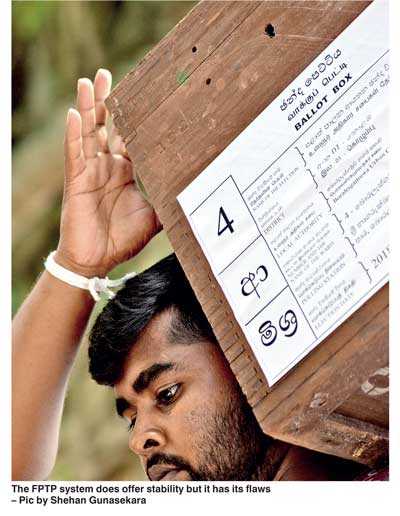Saturday Nov 15, 2025
Saturday Nov 15, 2025
Thursday, 17 May 2018 00:00 - - {{hitsCtrl.values.hits}}
In 2011, Nick Clegg the leader of the Liberal Democrats pushed for a British referendum to change the Westminster-style First Past the Post (FPTP) system. The Conservative Party opposed this move. The Labour Party wanted to move the system away from FPTP although sections of MPs within the Labour Party opposed it making the Labour Party divided as a result. Labour vote base is in the cities while the Conservative vote base comes from outside the city areas of UK. 
A similar comparison can be made to Sri Lanka. The UNP similar to the Labour Party draws its support from the cities while the SLFP like the Conservatives, draws its support from the rural areas. The UNP and the Labour party are similar in the sense they draw urban votes and both of them are no fans of the FPTP system. Labour have not been able to change the British system away from the FPTP but the UNP under President J.R. Jayawardene managed to change it after the UNP victory at the 1977 polls. Why are parties like the Labour Party and the United National Party against the FPTP system? Let us look at Sri Lanka’s experience.
Sri Lanka’s experience with First Past the Post system
After the 1977 general elections, the UNP changed the First Past the Post (FPTP) system to the Proportional Representation (PR) system. The UNP won a 5/6th majority in Parliament. Many to this day call the 1977 win a landslide victory for the UNP. But was it a landslide victory? The UNP in 1977 only won 50.9% (barely past the 50%) in 1977 but ended up with 83.3% of the seats. It wasn’t a landslide victory by votes. It was just a landslide victory according to the FPTP system. If the 1977 elections were held under the current PR system, the UNP would have barely scraped past the 113 seats needed. But why would J.R. Jayawardene change a system which gave him 83% of the seats for only 50.9% of the votes?
A look at the 1970 general elections gives the answer. In the 1970 general elections, the UNP got over 50,000 votes more than the SLFP but the UNP only won 17 seats while the SLFP won 91 seats. Same as in the Indian general elections of 2014 (under the FPTP system), when Narendra Modi led BJP won with only 31.3%. This is the main problem with the FPTP system. Someone who gets less votes than his opponent can still win. In India, around 70% of the Indian population did not vote for the BJP but the BJP won comfortably. Can we call this democracy?
First Past the Post has its benefits
Firstly, FPTP gives a no-nonsense, stable government with a comfortable majority in most cases. As we  experienced in Sri Lanka before our Constitution was changed. People would vote for either the UNP or SLFP led coalition and each will have a comfortable majority. This led to a stable government for the next five years where the party can implement its policies in the country. Compare this to the PR system in which Sri Lanka had seven general elections; five out of seven times, there was a hung parliament where no party got a majority of the seats in Parliament. Only in the general elections in 1989 and 2010 were majorities won.
experienced in Sri Lanka before our Constitution was changed. People would vote for either the UNP or SLFP led coalition and each will have a comfortable majority. This led to a stable government for the next five years where the party can implement its policies in the country. Compare this to the PR system in which Sri Lanka had seven general elections; five out of seven times, there was a hung parliament where no party got a majority of the seats in Parliament. Only in the general elections in 1989 and 2010 were majorities won.
Secondly, the Member of Parliament is closer to his/her constituency. As each constituency is guaranteed a member of parliament as someone has to win. Under PR, certain constituencies in Sri Lanka do not have an elected MP currently in Sri Lanka.
Lastly, the FPTP system keeps out extreme and fringe parties. In the 2015 British general elections, the far right party UKIP of Nigel Farage got nearly four million votes which is over 12% of the British votes but only got one seat out of 650 seats. If Britain had a PR system, the UKIP would have ended up with over 10% of the seats and could well have been in the kingmaker seat influencing British policy with their extreme far right views.
Flaws in the First Past the Post system
We spoke about extremists not being able to win many seats as an advantage. This is a positive aspect, however, this system also makes certain parties with good agendas get fewer seats like the Liberal Democrats and the Green Party at the 2015 British general elections. The Liberal Democrats led got nearly 8% of the votes but ended with only 1.2% of the seats in Parliament, that is just eight seats out of 650 seats in the British House of Commons. The Green Party received a similar treatment where the Green Party got over a million votes but just one seat. But the less democratic point is in relation to the Conservatives, led by David Cameron, which won the elections. The Conservatives won just 36.8% of the votes. The uncomfortable truth is a party which did not get the votes of around two thirds of the population won the elections. The FPTP offers stability but at what cost?
The First Past the Post system also does not help parties representing the smaller sections of the political divide. For example, the vast majority of Sri Lankan votes come from rural areas. So urban voters in Sri Lanka can be categorised as a minority in the urban rural divide. The FPTP does not favour urban voters as the rural community decides the elections which explains why the urban voters backed Labour Party and the UNP do not favour the FPTP.
To elect an MP under the FPTP system, the party has to poll the most number of votes in that particular electorate. With the majority of constituencies in the rural areas, the swing towards the winner is decided in the nonurban areas. Just as in the United States which has a FPTP for its electoral college system. The party that polls highest for a state in America wins all electoral college votes. States such as New York or California which have the financial decision makers are always Democratic. It is just a few swing states such as Ohio which determine the election results. In Sri Lanka’s political long term interest, this kind of a system would not be recommended.
There is less of diversity as all the political views are in a two-party system. There is no third way as either one of the two mainstream dominant parties win comfortably even when they get less than one-third of the votes. Parties representing diverse values are left out. The people are stuck between, in many cases slightly different mainstream ideas of two parties which have been taking turns for decades. There is little change.
Over time as it happened in Britain, people tend to just vote for the two mainstream parties because their votes for a third or fourth party does not matter. The four million votes (12%) of the British votes for the UKIP only got the UKIP one seat out of 650 seats. Those four million voters will lose faith in the system and may not even bother to vote in future elections. When people lose faith in elections, it is not a good sign for democracy and can make people want to express their voices in more undemocratic ways.
The British referendum of 2011: Would voters prefer a First Past the Post system?
Many British people refer to the 2011 referendum which rejected a change to the FPTP system as proof that the people like this system. Observers around the world also use it to say that people love the FPTP system.
There are three points to be noted very carefully here about the 2011 UK referendum. One, only 42% of the people turned out to vote at the referendum as electoral systems and the complexity of how it works are more academic and as a whole the layman has little knowledge or understanding about the FPTP or the PR system.
Two, the question at the referendum was “At present the UK uses the FPTP to elect MPs to the House of Commons. Should the Alternative vote (AV) system be used instead?” It was more of a question about whether the UK wants a system of AV rather than about a vote on FPTP. Alternative vote is different to the Proportional Representation system. Alternative Vote is about bringing in preferential votes so candidates in a constituency who do not get 50% of the first preference votes have to get a number of second or third preference votes to win. AV is more of a modification of the FPTP rather than a complete change to a PR system. So the 2011 British referendum is not exactly a vote for the first past the post system. The referendum was not even about a vote on FPTP vs. PR. That can explain why the Labour Party was divided on the referendum.
Lastly, the Liberal Democrats, a third force in British politics fully backed a change. The Conservatives fully campaigned against change. But Labour, though largely supportive of change, had many MPs being against change. Therefore it was more of a divided Labour Party half-heartedly backing change. So with just the Liberal Democrats campaigning for change with the Conservatives against it and Labour divided, it was a tall task as party supporters tend to vote along party lines.
Should we go back to the First Past the Post system?
The FPTP system does offer stability and offers a much better relationship between the Member of Parliament and his/her constituency. It also keeps away the fringe parties out of the system. But it has its flaws. The FPTP system does allow a party with less than one-third of the votes to be in power. We are talking about a government that did not get the votes of more than two-thirds of the country. It does not help the minority views to be represented in Parliament. There is less diversity of parties with different ideas being able to influence the Government for the better as the FPTP system keeps a two-party system intact. As the two largest parties win comfortably, even with less than one-third of the votes at times, neither of the parties need the support of the smaller parties. Even if the smaller parties get some seats through the FPTP system which is very unfriendly to smaller parties, they cannot influence a government by being in a kingmaker position.
The FPTP system usually gets decided by the rural community. Whichever way they vote swings the results. The United States has a system for the presidential elections as I explained above, through something similar to the FPTP. A few swing states like Ohio decide who wins. And look where the 2016 US Presidential elections took America.